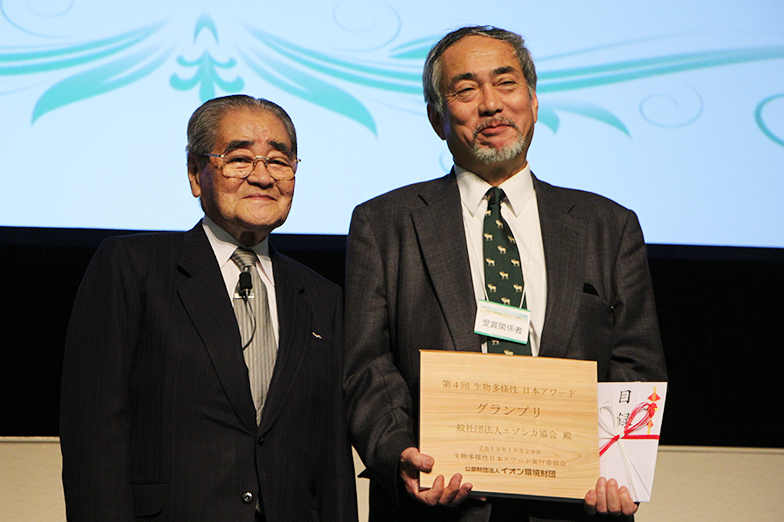Ezo deer resource utilization wins top prize ~ Biodiversity Japan Awards ceremony held
The Aeon Environmental Foundation held the 4th "Biodiversity Japan Awards" ceremony on October 20 at the U Thant International Conference Hall of the United Nations University in Shibuya, Tokyo. Five initiatives recognized for outstanding contributions to biodiversity conservation and sustainable use were honored with Excellence Awards. From among these Excellence Award winners, the Ezo Deer Association's "Project to Promote Advanced Resource Utilization of Ezo Deer" was selected as the Grand Prize winner.

At the ceremony, Takuya Okada, Chairman of the Aeon Environmental Foundation and Chair of the Award Selection Committee, delivered opening remarks on behalf of the organizers. He emphasized that the number of entries has increased annually, with 126 submissions from across Japan this year, indicating the award's growing societal recognition. "All the initiatives honored this time are internationally applicable. Environmental issues know no borders. Addressing biodiversity and other environmental challenges, along with achieving sustainable social development, requires efforts that transcend national boundaries," he stated, calling for continued commitment and cooperation in environmental and social contribution activities.
Next, five activities were honored with Excellence Awards. These included the Ezo Deer Association's "Project to Promote Advanced Resource Utilization of Ezo Deer," Ito En's "Biodiversity Conservation Efforts through the 'Beautify Lake Biwa with Tea, Beautify Japan with Tea' Project," and the Kyushu River Support Group / Kyushu University Shimotani Laboratory's "Practices for Conservation and Restoration of Riparian Environments and Regional Revitalization," Groundwork Mishima's "Revitalizing and Restoring the Ditch River into a 'Hometown River' for Diverse Creatures by Pooling Citizen Power," and Kesennuma Municipal Ohya Junior High School's "Ohya Hummingbird Project." Representatives from each project took the stage to receive award plaques, supplementary prizes, and commemorative gifts from Chairman Okada.

Professor Seiji Kondo of Hokkaido University's Graduate School of Agricultural Science, who also serves as Chairman of the Ezo Deer Association and was selected for the Grand Prix, shared his joy at receiving the award and introduced the association's activities on stage.
Ezo deer in Hokkaido were nearly extinct for about 100 years due to overhunting and heavy snowfall in the early Meiji period. The culture of utilizing Ezo deer meat also disappeared. However, starting in the 1990s, Ezo deer populations suddenly began to increase. The optimal population size for sustainable balance with their plant food sources is considered to be 200,000 head, but the association's activities have finally brought the population below 500,000 head.
Professor Kondo explained the philosophy: "When one species proliferates excessively, biodiversity collapses. Our association, the Hokkaido government, and the people of Hokkaido aim to collectively manage the population to around 200,000 through human effort. It's not just about reducing numbers; we want to bring Ezo deer raised on self-produced feed to the dinner table and utilize every part—the skin, bones, and antlers—to honor their lives."
Next, review committee member Manabu Akaike, Director of the Universal Design Research Institute, commented that this award-winning initiative can be evaluated under two keywords: "Working Together" and "Biodiversity Plus." He highly commended how each organization achieved results by engaging diverse stakeholders—including citizens, government, producers, educational institutions, and NPOs—for biodiversity conservation, restoration, and resource utilization, while also bringing added value to the region through industrial promotion and other initiatives.

Next, Mr. Kimio Okushi, Director-General of the Nature Conservation Bureau at the Ministry of the Environment, took the stage. Alongside his congratulatory remarks, he stated his aspiration: "To achieve the Aichi Targets adopted at COP10, all local governments must share a sense of urgency and strengthen collaborative efforts. The Ministry of the Environment will also promote the mainstreaming of biodiversity and work closely with the foundation."

During the award winners' presentations, the five winning organizations explained their respective activities. For the Excellence Award-winning "Otani Hummingbird Project," two students from Kesennuma Municipal Otani Junior High School took the stage.
Despite suffering damage from the Great East Japan Earthquake on March 11, 2011, the project persistently continued efforts to restore Oya's nature. These included cultivating pine forests, farming wakame seaweed, and implementing "fuyumizutanbo" – flooding rice fields in winter to regenerate soil fertility. They appealed to the audience, saying that just as the hummingbird in the story drops a single drop of water on a large wildfire, everyone can start with what they can do, and together it becomes a great force. This drew loud applause from the venue.

Following the awards ceremony, Professor Takayuki Nagashima from Tokyo University of Agriculture's Faculty of Agriculture delivered a lecture titled "Manufacturing Inspired by Biodiversity: Insect Technology." He introduced technologies for the sustainable societal utilization of insects—which comprise 80-90% of all animals—including research on silk, the fibrous protein produced by insects like silkworms. He emphasized that balancing global environmental conservation with economic activity enables the natural sustainability of biodiversity.

Celebrating its 25th anniversary this year, the foundation established two awards in 2010, the International Year of Biodiversity, following the 10th Conference of the Parties (COP10) to the Convention on Biological Diversity held in Japan. These awards aim to promote the conservation and sustainable use of biodiversity.
One is this domestic award, while the other is the international "MIDORI Prize for Biodiversity." The former honors outstanding projects, and the latter recognizes individuals with remarkable contributions, alternating every other year.
Was this article helpful?